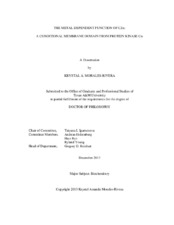| dc.contributor.advisor | Igumenova, Tatyana I | |
| dc.creator | Morales-Rivera, Krystal A. | |
| dc.date.accessioned | 2014-05-13T17:06:46Z | |
| dc.date.available | 2015-12-01T06:31:20Z | |
| dc.date.created | 2013-12 | |
| dc.date.issued | 2013-11-26 | |
| dc.date.submitted | December 2013 | |
| dc.identifier.uri | https://hdl.handle.net/1969.1/151621 | |
| dc.description.abstract | Protein Kinase C (PKC) isoforms function in signaling pathways responsible for controlling cell proliferation, survival and apoptosis. Up or down-regulation of PKCs has been implicated in cancer progression, cardiovascular dysfunction, and neurological disorders. Moreover, the conventional Protein Kinase Calpha (PKCalpha) has also been identified as an important molecular target in Pb2+ poisoning. Two out of three Pb^(2+) sites in full-length PKCalpha were mapped onto its C2 domain (C2alpha), which associates with anionic membranes in response to binding Ca^(2+) ions in the first step of activation. The objective of this work was to determine the specific role of divalent metal ions on the modulation of C2alpha structure, function, and interactions with other PKCalpha domains.
Nuclear magnetic resonance (NMR) and Förster resonance energy transfer were used to characterize the specific role of divalent metal ions in C2alpha membrane-interactions. Pb^(2+) and Cd^(2+) ions bind C2alpha with high affinity. Pb^(2+) drives C2alpha association with lipid-membranes, whereas Cd^(2+) does not support membrane-binding. This work provides direct evidence for the specific role of divalent metal ions in mediating protein-membrane interactions and illustrates the opposite responses produced by toxic metal ions in a single molecular target.
The structures of metal-free (1.9 Å) and Pb2+-bound (1.5 Å) C2alpha were determined using X-ray crystallography. These revealed a remarkable coexistence of hemi- and holo-directed coordinated geometries for the two Pb^(2+) ions that are bound to the Ca^(2+) binding loops (CBLs). The overall backbone conformation does not change upon metal-binding. However, elevated B-factors were observed in the CBLs of metal-free C2alpha, suggesting that this region is dynamic. NMR techniques were used to identify the dynamic regions and to quantify the timescales of C2alpha motions in different states of metal ligation. Metal-binding quenches the microsecond-timescale motions of the CBLs but results in elevated millisecond-timescale dynamics of the N- and C-terminal regions. These regions are implicated in the interactions of C2 with other regulatory domains of PKC. Our data suggest that the changes in protein dynamics is a mechanism by which the information about the metal-binding event propagates to other regions of the protein.
We then extended our structural and dynamical studies to the two-domain construct of PKCalpha comprising two regulatory domains, C1B-C2. NMR chemical shift perturbation and dynamic studies showed that these domains do not behave as independent modules in solution. The linker region connecting the functional modules shows significant chemical shifts and conformational dynamic changes induced by Ca^(2+)-binding. These results support our hypothesis that Ca^(2+)-binding triggers the rearrangement of the C1B and C2 domains. The strategy of using paramagnetic relaxation enhancement experiments to refine the C1B-C2 structure is presented.
A prevailing view in the PKC field is that the function of metal ion is to alter the electrostatic potential of the C2 domain and thereby facilitate the protein insertion into the negatively charged membranes. The results of our work support the multi-faceted role of metal ions, which includes the formation of specific coordination bonds with lipid head groups, as well as the modulation of protein dynamics and inter-domain orientation. | en |
| dc.format.mimetype | application/pdf | |
| dc.language.iso | en | |
| dc.subject | Protein Kinase C | en |
| dc.subject | C2 domain | en |
| dc.subject | peripheral membrane protein | en |
| dc.subject | Nuclear Magnetic Resonance | en |
| dc.subject | Calcium | en |
| dc.subject | Lead poisoning | en |
| dc.title | The Metal-dependent Function of C2α: A Conditional Membrane Domain from Protein Kinase Cα | en |
| dc.type | Thesis | en |
| thesis.degree.department | Biochemistry and Biophysics | en |
| thesis.degree.discipline | Biochemistry | en |
| thesis.degree.grantor | Texas A & M University | en |
| thesis.degree.name | Doctor of Philosophy | en |
| thesis.degree.level | Doctoral | en |
| dc.contributor.committeeMember | Holzenburg, Andreas | |
| dc.contributor.committeeMember | Rye, Hays | |
| dc.contributor.committeeMember | Young, Ryland | |
| dc.type.material | text | en |
| dc.date.updated | 2014-05-13T17:06:46Z | |
| local.embargo.terms | 2015-12-01 | |


